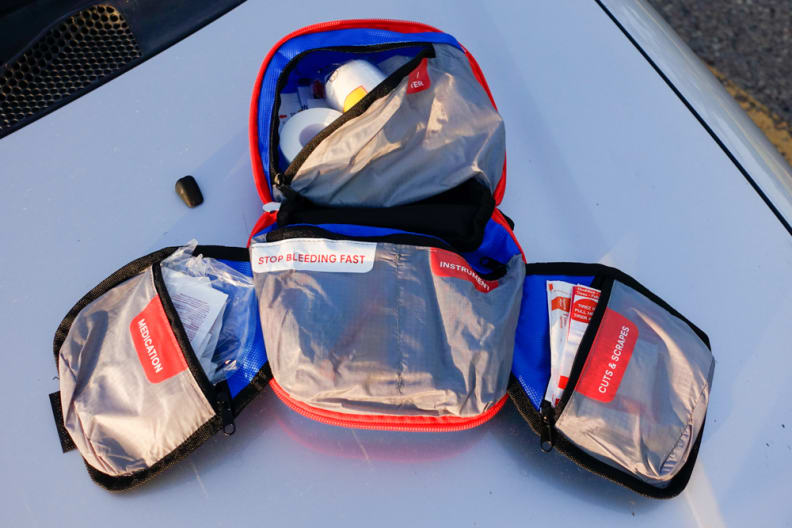Products are chosen independently by our editors. Purchases made through our links may earn us a commission.
When most people think about getting their cars ready for winter, they only think about getting snow tires. However, there’s a lot more to think about if you want to maximize your safety and comfort when driving when the cold weather settles. Not to worry though, we’ve got 14 tips that could save you a lot of pain down the road.
After you’re done making sure your car is ready for the cold, be sure to winterize your home to save money on your heating bill.
1. Make sure you’re caught up on maintenance
Going in for a tuneup is a great way to ward off problems later. A quick check of your owner’s manual will inform you how many miles you have to go before your next checkup.
2. Get an oil change
Skipping an oil change can catch up with you in the winter. Dropping temperatures cause your oil to thicken, making it harder for your engine to stay lubricated.
3. Change your wiper blades and top off windshield fluid
Visibility can get really low during a snowstorm. Don’t let worn down wiper blades and a lack of windshield fluid add to your problems. Be sure to buy a fluid with de-icer in it, to make sure it can deal with frosty conditions.
4. Inspect all your lights and cameras
Remember that you have more than just headlights—your brake lights and turn signals alert other drivers. Don’t forget to check that your cabin light is in working order, too! For newer vehicles, be sure to keep your rear and side cameras clear. People tend to forget how quickly you become dependent on them.
5. Make sure your battery is charged
The winter cold can push a half-dead battery to full-dead. That’s because your car battery produces electricity via a chemical reaction and, like all reactions, is less effective at lower temperatures. You should have your car battery checked out by a mechanic so ensure that it’s in working order.
6. Check your tire pressure when it gets cold
The laws of physics state that the pressure of a gas has a direct relationship with the temperature. That means when it gets cold, your tire pressure will go down. Under-pressured tires are at risk of getting blown out because too much of the rubber is in contact with the road. If you find your tires are a little flatter than the owner’s manual recommends, it might be a good time to invest in a good air compressor kit. Our favorite after testing was the Viair 85P.
7. Check your treads
Have you heard of the penny trick? It’s one of the few still-useful things you can do with a penny and a simple gut check to see if your tires need changing. Insert a penny with the top of Lincoln’s head facing toward the tire into your tread (the grooves in your wheels). If you can see all of Lincoln's face, your tires are balding and need replacement. The tread on your tires is what grips your wheels to the road and without them you’ll skid all over the place.
8. Freshen up your coolant
It sounds a bit like an oxymoron, but coolant keeps your engine from freezing. Your coolant needs to be changed out every few years, so if you can’t remember the last time it was drained and replaced, you should probably look into that.
9. Winterize your doors and trunk
If you park outdoors, your vehicle is prone to getting iced over. During the day, your car warms up, causing snow to melt. That water runs into every nook and cranny, like the gasket in your doors and your trunk. At night, that water freezes, making it difficult to open your car. You can prevent these from freezing shut by applying a silicone lubricant.
10. Test out your heater
Your heater is not only for comfort, but it's important for defrosting and visibility. If it takes forever to heat your cabin up, that’s a sign that you need to get your heater core flushed.
11. Keep your gas tank topped up
During the winter months, condensation can build up in your fuel lines. If you’re running on fumes, that water buildup in your lines might freeze. You can prevent this by either adding an antifreeze fuel additive or by always keeping your gas tank at least one-quarter full.
12. Check your brakes
When you pump the brakes, do you hear a whining? That’s a sign you need to have your brake pads replaced. Remember that in icy conditions mean that you have less time to react.
13. Know your car and all its features
Does your car have all-wheel drive or two-wheel drive? Is it engaged all the time or do you need to manually activate it? Does it have anti-lock brakes? These are questions you should know the answer to. Knowing all the features could help give you that extra oomph to break through that snowbank. Be sure to consult the owner’s manual.
14. Get a car survival kit

In the event of an accident, a first aid kit may save a life.
Regardless of the weather, you should drive with at least a first aid kit, flares, and seat belt cutter. However, for any long-distance drive, we’d suggest reading through this article about roadside emergency tools. At the very least, you should have a first aid kit worth its salt.


